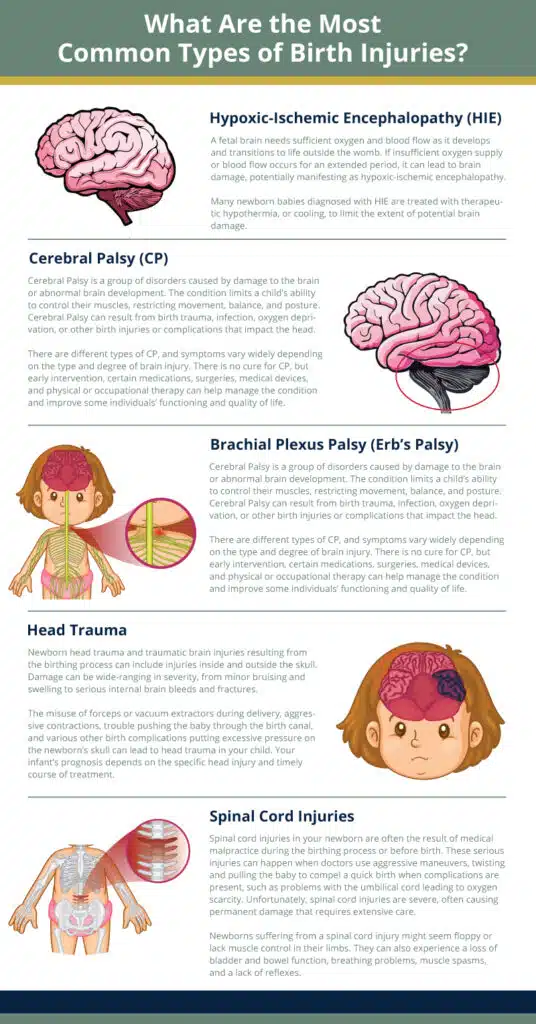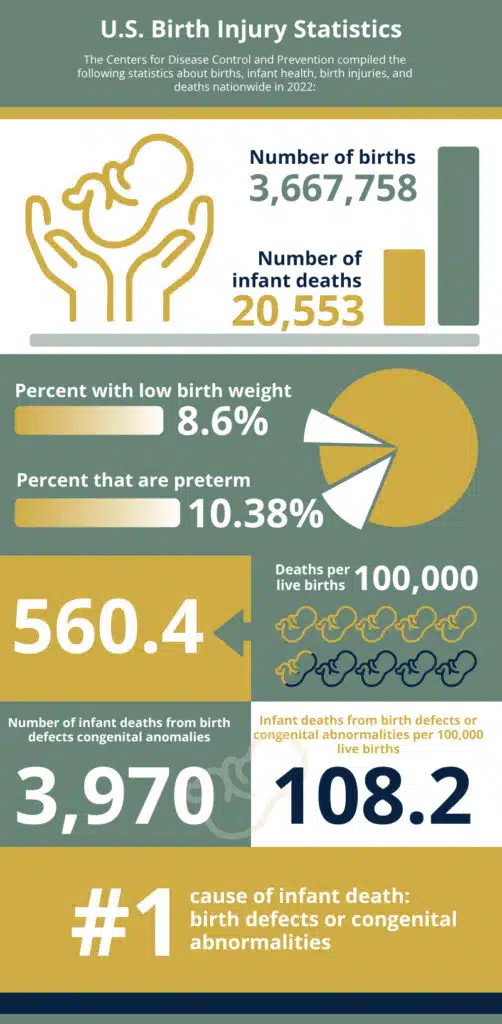Chicago Birth Injury Lawyer
Injuries suffered at birth can be life-altering for both the child and the mother, leaving families with questions about the future and piles of medical bills. At Levin & Perconti, we understand that your immediate goals are to resolve your medical bills and plan for future treatment. Our experienced Chicago birth injury attorneys can discuss your situation and explain your legal options, working diligently to ensure your family’s needs are met as quickly as possible.
- Can I Sue for a Birth Injury?
- About Our Chicago Birth Injury Lawyers
- Why Should I Hire a Chicago Birth Injury Lawyer?
- Frequently Asked Questions (FAQs) About Birth Injuries
- What Are the Most Common Types of Birth Injuries?
- What Are the Most Common Causes of Birth Injuries?
- What Compensation Can I Recover in a Chicago Birth Injury Case?
- Levin & Perconti Can Help After Your Child’s Birth Injury
- U.S. Birth Injury Statistics
Though you can’t undo the harm a health care provider’s negligence caused your infant and family, a lawsuit can hold those responsible for your child’s birth injury accountable for the financial consequences and suffering that result. As a parent or guardian of an injured child, you have the right to fair compensation to help offset the present and future costs that come with their injury.
Can I Sue for a Birth Injury?
Birth injury litigation stems from an injury to a baby during pregnancy, labor, or delivery or shortly after birth due to careless, negligent, or intentional acts by a doctor, nurse, hospital, or other medical professional or facility. If your baby has suffered a birth injury due to a health care provider’s actions or omissions, you might have grounds for filing a lawsuit.
In a birth injury lawsuit, you can seek compensatory damages for financial, physical, and emotional losses. In birth injury cases, this compensation can be substantial, covering the child’s past and future medical expenses, disability, disfigurement, pain and suffering, and more.
Parents who suspect their child has suffered a birth injury should consult a Chicago medical malpractice law firm with experience in birth injury litigation as soon as possible.
Who Can File a Birth Injury Lawsuit?
In Chicago, parents can file a birth injury lawsuit if their child’s health condition was caused by a medical professional’s negligence before, during, or shortly after the child’s birth. These lawsuits can be filed against doctors, nurses, labor and delivery staff, midwives, hospitals, and other parties, depending on the circumstances of the injury.
How to Prove Medical Negligence in a Birth Injury Case
To prove medical negligence in a birth injury lawsuit in Illinois, you must establish a provider-patient relationship between the mother and the health care provider, giving rise to a duty of care. Then, you must show that the provider deviated from the accepted standard of care required from a reasonable provider under similar circumstances. Finally, you must establish that the negligent party’s deviation from their standard of care caused your child’s injury and resulting damages.
When working with a birth injury attorney, your lawyer will investigate and gather all available evidence to build a case establishing that someone’s negligence caused harm to your child.
About Our Chicago Birth Injury Lawyers









At Levin & Perconti, our birth injury team in Chicago has earned national recognition for its success and client service. Our skilled attorneys have litigated cases throughout the United States and passionately advocate for every family they represent.
Two of the attorneys on Levin & Perconti’s birth injury team, Dov Apfel and Seth Cardeli, have presented at dozens of educational events and written for numerous publications on their work in birth injury law. In 2020, Dov and Seth secured one of the country’s largest medical malpractice settlements, cementing their status as two of the leading birth injury attorneys in the nation. Seth also worked with fellow Levin & Perconti attorneys Mike Bonamarte and Cari Silverman to secure the largest birth injury settlement in Illinois outside of Cook County.
In 2023, Levin & Perconti’s Margaret Battersby Black was bestowed the “Carole K. Bellows Women of Influence” award, which honors those who advocate for action addressing women’s issues and promote women’s involvement in the legal community at all levels. The firm’s additional birth injury lawyers, including Jaime Koziol Delaney, Isabela Bacidore, Jenna Ewing, and Megan O’Connor, have also received awards and recognition for their work representing families dealing with the devastating effects of birth injuries.
“From my first call to my last the last call the experience was above and beyond excellent, Professional, Personal and more than helpful. At the same time it always felt like they were Family!!!! Words can’t describe the passion and caring my whole family felt…” – Phil, Google
Our Birth Injury Case Results
The birth injury attorneys at Levin & Perconti have handled numerous birth injury cases over the years, securing several significant settlements and awards, including:
- $40 Million Verdict: In March 2023, a jury awarded a 19-year-old woman and her parents $40 million for birth injuries sustained due to a delayed C-section delivery at Sarah Bush Lincoln Health Center in Mattoon, Illinois.
- $29 Million Settlement: In December 2023, the firm secured a $29 million settlement for a child who suffered brain damage and other injuries after a delayed cesarean section.
- $20 Million Verdict: In June 2022, a $20 million verdict was obtained for a child who suffered preventable hypoxic-ischemic encephalopathy (HIE) and asphyxia injuries at birth, resulting in permanent cognitive and developmental impairments.
- $14 Million Verdict: A $14 million verdict was awarded for a child who suffered a brain injury due to lack of oxygen during birth. Despite nonreactive fetal heart tracings, the hospital failed to promptly respond to fetal monitoring and did not arrange for a timely C-section.
- $11.5 Million FTCA Settlement: A $11.5 million settlement was secured for a child born at the U.S. Naval Hospital in Guam who suffered a catastrophic hypoxic-ischemic brain injury as a result of a negligent neonatal resuscitation and intubation.
- $9 Million Settlement: A settlement to the family of a baby who suffered permanent brain damage as a result of a doctor’s failure to test the mother for Group B Strep Meningitis during prenatal care.
- $6.71 Million Verdict: A $6.71 million verdict was obtained against a hospital where an inexperienced resident performed a vaginal delivery of a breech presentation, resulting in shoulder dystocia and a crippling brachial plexus arm injury.
- $6.5 Million Settlement: A $6.5 million settlement was reached for a young girl who suffered a brain injury during birth, resulting in cerebral palsy, after physicians failed to timely perform a C-section.
- $4.5 Million Settlement: A $4.5 million settlement was secured for a newborn who suffered a perinatal stroke, brain bleeds, and skull fractures during birth due to a negligent forceps delivery, resulting in cerebral palsy.
- $4.5 Million Settlement: A $4.5 million settlement was obtained for a child who suffered brain damage causing cerebral palsy as a result of a family practice physician’s failure to perform a timely Caesarean section in the face of fetal distress.
- $3.5 Million Settlement: A $3.5 million settlement was reached for the family of a newborn boy who died as a result of medical malpractice during birth. The attending physician continued to attempt a vaginal delivery in the face of fetal distress and failed to perform a timely C-section.
Why Should I Hire a Chicago Birth Injury Lawyer?
If your child suffers an injury due to a physician’s negligence or malpractice, you might be able to recover compensation for your physical, emotional, and financial damages. It’s important to have a birth injury lawyer by your side to help you navigate your available legal options, collect the necessary evidence to support your claim, prepare the required paperwork to initiate a lawsuit, and file your case appropriately and timely.
A Chicago birth injury lawyer from Levin & Perconti can provide you with the following services:
Free Birth Injury Case Evaluation
You can schedule a free, no-obligation consultation with our birth injury attorneys. The highly confidential consultation lets us gather all the details about your child’s birth injury to build a robust case against the negligent hospital, birthing facility, or health care provider. We’ll also help you understand your legal rights and decide the best course of action for you and your family.
Comprehensive Claim Investigation
Our legal team takes no chances when getting to the bottom of your baby’s birth injuries. Upon signing a release form, we’ll dive deeper into an analysis of your medical records covering your pregnancy, birth, and postnatal care. We might also engage medical experts to reconstruct the birth injury and interview witnesses to shed more light on how the damage happened.
Filing a Lawsuit
If medical experts determine that your baby’s birth injuries occurred as a result of negligence by a hospital, birthing facility, or health care provider, we’ll proceed to file a lawsuit with the appropriate state or federal court.
Discovery
Once a birth injury lawsuit is filed, we can engage in discovery to uncover additional evidence about why the hospital, birthing facility, and/or health care provider provided negligent care to you and your baby. This discovery will include document and record requests, depositions of the parties, depositions of fact witnesses, and expert disclosures and depositions. During the discovery phase of the lawsuit, we use our extensive knowledge of birth injury litigation to put together the strongest case possible.
Settlement Negotiations
We are trial lawyers first. However, sometimes in litigating birth injury cases, the opposing party will request that we engage in settlement negotiations to avoid the risk to both parties of going to trial. If such negotiations are successful and the opposing party is willing to pay fair compensation, then the case may be resolved at this point in the process.
Preparing for Trial
If the defendant refutes their liability, the next step would be to take your case to trial. Our trial attorneys are always ready to represent you and fight for your justice. We’ll formulate the strongest case possible by presenting witness testimonials and expert-based exhibits, proving that your child’s birth injury resulted from the defendant’s negligence.
Collection and Disbursement of Funds
If the jury determines that the defendant was responsible for your child’s birth injury, it’ll award compensation equivalent to the financial and emotional damages you’ve suffered. Our birth injury attorneys will work quickly to collect and transfer the payment to your account as soon as possible. We’ll also resolve any liens connected to your recovery.
“Levin & Perconti did more for my family and I than they would ever know…” – Zoë, Google
Frequently Asked Questions (FAQs) About Birth Injuries
As an expectant or new parent, you likely have many questions and concerns about birth injuries, including what they are, how to avoid them, and what to do if your child suffers from one. Our birth injury attorneys are here to provide you with much-needed answers and guide you in supporting and protecting your family through this difficult time. Here are some common questions we receive:
What is the difference between birth injuries and birth defects?
A birth defect or congenital disability is a health condition or abnormality that forms while the infant is still in the womb. Doctors must report these conditions to the expectant parents before delivery. Although birth defects can be unavoidable, your health care provider should take appropriate actions or provide necessary medical care to mitigate the effects or harm caused by a birth defect when possible. Contrarily, a birth injury usually occurs just before or during labor or at or around the time of delivery and is often preventable and caused by a physician’s or medical staff’s negligence.
What are the signs and symptoms of a birth injury?
If your newborn exhibits the following signs and symptoms, they’ve most likely sustained a birth injury:
- Swelling, bruising, or abrasions
- Seizures within 48 hours of birth
- Loose or limp arms
- Failure to begin breathing immediately after delivery
- The infant’s need for a breathing tube or resuscitation after delivery
If you see any behaviors or symptoms in your infant that seem abnormal or “off,” including difficulty eating, swallowing, or breathing, it’s a good idea to have them evaluated by a pediatrician or other medical professional.
What Is the Deadline for Filing a Birth Injury Case in Chicago?
Illinois has a time limit for filing a birth injury lawsuit. In most cases, parents have until their child’s eighth birthday to file suit. However, the deadline can vary based on the severity of the injury, who is filing the claim, and when the injury was discovered. For wrongful death claims, the statute of limitations is just two years from the death. If your claim is not filed before the birth injury statute of limitations expires, you may lose your right to hold the negligent health care providers accountable.
How Do I Find the Best Birth Injury Lawyer Near Me?
Choosing the right birth injury attorney can substantially improve the results of your legal claim when a negligent health care provider harms your child. Illinois’s best medical malpractice lawyers have significant financial resources, a network of trusted expert witnesses, and a proven track record of experience litigating medical malpractice cases like yours. You should feel comfortable with your choice of attorney, and they should not require any upfront payment.
What Are the Most Common Types of Birth Injuries?
Countless actions taken by hospital or birthing facility staff can lead to birth injuries, varying in severity, treatability, and long-term prognoses. Your baby’s condition may lead to ongoing risks and complications in other situations, requiring future surgeries, full-time care, and ongoing treatment. Some of the most common types of birth injuries in Chicago include the following:
Hypoxic-Ischemic Encephalopathy (HIE)
A fetal brain needs sufficient oxygen and blood flow as it develops and transitions to life outside the womb. If insufficient oxygen supply or blood flow occurs for an extended period, it can lead to brain damage, potentially manifesting as hypoxic-ischemic encephalopathy.
Many newborn babies diagnosed with HIE are treated with therapeutic hypothermia, or cooling, to limit the extent of potential brain damage.
Cerebral Palsy (CP)
Cerebral Palsy is a group of disorders caused by damage to the brain or abnormal brain development. The condition limits a child’s ability to control their muscles, restricting movement, balance, and posture. Cerebral Palsy can result from birth trauma, infection, oxygen deprivation, or other birth injuries or complications that impact the head.
There are different types of CP, and symptoms vary widely depending on the type and degree of brain injury. There is no cure for CP, but early intervention, certain medications, surgeries, medical devices, and physical or occupational therapy can help manage the condition and improve some individuals’ functioning and quality of life.
Brachial Plexus Palsy (Erb’s Palsy)
The most common type of brachial plexus palsy is Erb’s palsy, which affects the shoulder and elbow muscles in up to 2.5 of every 1,000 live-born babies. It’s often the result of a difficult birth, leading to the improper bending or stretching of the newborn’s head and neck.
The brachial plexus is a tangle of nerves near the neck that send signals to the nerves in a person’s arms. Damage to the nerves of the brachial plexus can result in partial or total paralysis of a child’s arm. If the child’s injury persists after physical and occupational therapy, they might need surgery to repair the nerves and regain feeling and movement in their arm.
Head Trauma
Newborn head trauma and traumatic brain injuries resulting from the birthing process can include injuries inside and outside the skull. Damage can be wide-ranging in severity, from minor bruising and swelling to serious internal brain bleeds and fractures.
The misuse of forceps or vacuum extractors during delivery, aggressive contractions, trouble pushing the baby through the birth canal, and various other birth complications putting excessive pressure on the newborn’s skull can lead to head trauma in your child. Your infant’s prognosis depends on the specific head injury and timely course of treatment.
Spinal Cord Injuries
Spinal cord injuries in your newborn are often the result of medical malpractice during the birthing process or before birth. These serious injuries can happen when doctors use aggressive maneuvers, twisting and pulling the baby to compel a quick birth when complications are present, such as problems with the umbilical cord leading to oxygen scarcity. Unfortunately, spinal cord injuries are severe, often causing permanent damage that requires extensive care.
Newborns suffering from a spinal cord injury might seem floppy or lack muscle control in their limbs. They can also experience a loss of bladder and bowel function, breathing problems, muscle spasms, and a lack of reflexes.

What Are the Most Common Causes of Birth Injuries?
Birth injuries can be the result of a health care provider’s wrong or negligent actions or inactions that lead to complicated and unsafe birthing experiences. According to a 2022 CDC report, the leading causes of infant deaths in the United States are congenital malformations and deformations, chromosomal abnormalities, disorders related to short gestation and low birth weight, and sudden infant death syndrome. For birth injuries, the most common causes include:
Birth Asphyxia
Asphyxia during the birthing process affects a baby’s brain and other vital organs due to essential oxygen and nutrient deprivation happening before, during, and immediately after delivery. This lack of oxygen leads to acid buildup in the cells, potentially causing far-reaching damage like brain injuries and cerebral palsy.
Birth Trauma
When excessive pressure or torsion is applied to the baby’s head or body, it can cause birth trauma. More damage can occur due to an overuse of delivery drugs, inept handling of labor, inappropriate use of forceps or vacuum, and other delivery complications contributing to lengthy and stressful births.
Over the last few decades, birth trauma rates have declined as obstetrical techniques advance and Cesarean sections for difficult deliveries become more common. Between 2004 and 2012, the birth trauma rate fell from 2.6 per 1000 live births to 1.9. Additionally, the number of forceps and vacuum-assisted deliveries has declined in recent years, further reducing the risk of trauma.
Viral and Bacterial Infections
When delivered vaginally, an infant is in direct contact with their mother’s birth canal during labor and delivery, exposing them to viruses and bacteria hosted in the mother’s body. While most of these maternal viral and bacterial strains are harmless, some are especially infectious and dangerous to newborns, affecting their brain and surrounding membranes, lungs, and spinal cord.
Generally, physicians must screen the mother for various infections as a part of routine prenatal care. Failing to screen and treat for infection can make a physician liable for birth injuries resulting from the infection.
Improper Prenatal Care
When providing prenatal care, medical professionals should perform routine ultrasounds and other testing to detect and remedy potential medical risk factors before they lead to complications. Proper prenatal care also includes adequately controlling existing maternal medical conditions and ensuring the mother’s physical and mental safety. Failing to provide this care may harm both the mother and the infant.
Untreated or Mistreated Maternal Medical Conditions
Maternal medical conditions left untreated or improperly treated can increase the risk of birth injuries. Therefore, regular screening and treatment are important to prevent serious outcomes.
The following maternal medical conditions can make a pregnancy high-risk, meaning both the mother and the baby may need extra monitoring and care to prevent birth injuries, stillbirth, and death:
- Cardiovascular problems affecting the heart and blood vessels
- Diabetes
- High blood pressure
- Obesity
- Certain infections, including urinary tract infections, human immunodeficiency virus, human papillomavirus, tuberculosis, viral hepatitis, and other sexually transmitted infections
- Blood clots
- Bleeding
- Anemia
- Severe nausea and vomiting
- Mental health conditions, including depression and anxiety
Medical Errors
Common medical errors that can lead to birth injuries include the following:
- Prescribing medication to the mother with dangerous side effects or known risks to the developing fetus
- Misusing the vacuum extractor or forceps during labor
- Administering the wrong medication
- Failing to respond promptly to maternal medical emergencies
- Failing to respond to changes in the fetal heart rate or fetal distress
- Miscommunications between physicians and nurses
- Premature delivery complications
- Delaying the performance of a C-section
What Compensation Can I Recover in a Chicago Birth Injury Case?
In a birth injury case, you may be able to recover economic and non-economic damages, depending on the circumstances of your child’s birth injury. Some cases also allow for the imposition of punitive damages to punish the wrongdoer for egregious actions. Economic damages include actual monetary or easily calculable losses, such as the following:
- Medical costs stemming from the injury
- Future medical and rehabilitation expenses
- Lost wages for missed work to care for your infant
- Caretaking expenses if you have to hire a professional caregiver
- Special education costs
- Special care equipment
- The child’s lost earning capacity
Contrarily, non-economic damages intent to compensate victims for non-monetary losses or harm, such as:
- Pain and suffering
- Loss of enjoyment of life
- Mental frustration
- Physical deformity
- Increased risk of future harm
- Shortened life expectancy

Long-term care and financial planning for birth injuries
It’s not uncommon for a successful birth injury lawsuit to cover the cost of care for the injured child for the rest of their life. However, if the compensation you recover does not cover all expenses associated with the care of your child, Illinois and the United States have several resources available for families struggling with finances due to birth injuries.
Available resources include the following:
- Division of Specialized Care for Children: The Division of Specialized Care for Children helps Illinois families with children who have special health care needs access services and resources.
- Government Programs for Children With Special Needs | SSA: The Social Security Administration provides many assistance programs for children with special needs and their families.
- Apply for a Grant | UnitedHealthcare Children’s Foundation: UnitedHealthcare Children’s Foundation is a 501(c)(3) charitable organization that provides medical grants to help children access health-related services not fully covered by their family’s insurance.
- Understanding a Special Needs Trust and Its Benefits: A special needs trust is a legal arrangement creating a fiduciary relationship that allows disabled or chronically ill people to receive income without reducing their eligibility for public assistance programs like Medicaid.
Levin & Perconti Can Help After Your Child’s Birth Injury
At Levin & Perconti, we’re a team of highly skilled and committed birth injury lawyers who fight to ensure you receive maximum civil justice for your child’s and your family’s injuries. We don’t hesitate to hold negligent people accountable, and we settle for nothing less than fair compensation for your emotional and financial suffering.
Complete our contact form today, and one of our attorneys will call you promptly to discuss your case and determine your legal options.
U.S. Birth Injury Statistics
The Centers for Disease Control and Prevention compiled the following statistics about births, infant health, birth injuries, and deaths nationwide in 2022:
- Number of births: 3,667,758
- Percent with low birth weight: 8.6%
- Percent that are preterm: 10.38%
- Number of infant deaths: 20,553
- Deaths per 100,000 live births: 560.4
- Number of infant deaths from birth defects or congenital anomalies: 3,970
- Infant deaths from birth defects or congenital abnormalities per 100,000 live births: 108.2
- #1 cause of infant death: birth defects or congenital abnormalities

Legally Reviewed by

Dov Apfel
Contact Us
- Free Consultation
- (312) 332-2872
"*" indicates required fields
Related Pages
- Birth Injury Lawyer
- Birth Asphyxia
- Brachial Plexus Injury
- Breech Birth Complications
- Cerebral Palsy
- Erb's Palsy
- Gestational Diabetes Misdiagnosis
- Hypoxic-Ischemic Encephalopathy (HIE)
- Neonatal Seizures
- Oxygen Deprivation
- Preeclampsia Misdiagnosis
- Shoulder Dystocia
- Statute of Limitations by State
- Stillbirth Lawsuit
- Umbilical Cord Compression
- Untimely C-Section
- Vacuum Extraction Injury
Notable Results
SETTLEMENT
for the family of a child who suffered brain injury due to lack of oxygen during her birth
SETTLEMENT
for a child who suffered brain damage causing cerebral palsy as a result of a family practice physician's failure to perform a timely C-section
VERDICT
for a child who died as a result of a doctor’s failure to diagnose the mother with an immune disorder while pregnant
Birth Injury Awards
In 2024, Michael Bonamarte, Seth Cardeli, and Cari Silverman won the Trial Excellence award at the Jury Verdict Reporter reception and awards ceremony for their groundbreaking $40 million verdict on behalf of a client who suffered a birth injury. This is the highest ever reported medical malpractice verdict outside of Cook County, IL at the time of reporting and the highest ever verdict in Coles County.
Our Office
325 N LaSalle Dr Suite 300
Chicago, IL 60654
312-332-2872